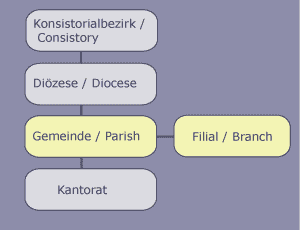 |
 |

|
General Structureof the Lutheran Augsburgian Church in PolandThe basic unit of the Church was the Parish and it's spiritual leader as representation of the Church within a limited territory. To simplify administration and supervision additional structures united bigger territories. Kantorate were subdivisions that sometimes divided parishes into small local units. |
||||||||||||
|
The chart shows the levels of the organization. | ||||||||||||
|
